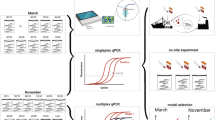Abstract
The importance of eating habits and the number of fish sampled in the estimation of mercury environmental contamination through biological indicators was studied. The species used were one with piscivorous habits (Anguilla anguilla) and another with omnivorous habits (Ciprinus carpio). From one original sample for each species, randomized samples were generated using the subroutine GGSRS from the mathematics library IMSL, and later the statistical significance of Pearson's correlation coefficient for the relationship between fish weight and mercury concentrations in muscle was obtained for each random sample. The results show that the use of omnivorous species such as Ciprinus carpio as a biological indicator of contamination enables us to carry out estimations with a greater degree of confidence than when piscivorous species such as Anguilla anguilla are used.
Similar content being viewed by others
References
Bull, K. R., Dearsley, A. F., and Inskip, M. H.: 1981, ‘Growth and Mercury Content of Roach (Rutilus rutilus, L.), Perch (Perca fluviatilis, L.) and Pike (Esox lucius) Living in Sewage Effluent’, Environ. Pollut. Ser. A. 25, 229–240.
Dagnelie, P.: 1975, Théorie et Méthodes Statistique. Ed. Les Presses Agronomique de Gembloux, ASBL Gembloux, Belgique.
Fagerström, T. and Assell, B.: 1973, ‘Methyl Mercury Accumulation in an Aquatic Food Chain. A Model and Some Implications for Research Planning’, Ambio 2, 164–171.
Grieb, T. M., Driscoll, C. T., Gloss, S. P., Schofield, C. L., and Porcella, D. B.: 1990, ‘Factors Affecting Mercury Accumulation in Fish in the Upper Michigan Peninsula’, Environ. Toxicol. Chem. 9, 919–930.
Hernando, J. A.: 1978, ‘Estructura de la Comunidad de Peces de la Marisma del Guadalquivir’, Ph.D. Thesis, Universidad de Sevilla, Spain.
Hildebrand, S. G., Strand, R. H., and Huckabee, J. W.: 1980, ‘Mercury Accumulation in Fish and Invertebrates of the North Fork Holston River, Virginia and Tennessee’, J. Environ. Qual. 9, 393–400.
I.M.S.L.: 1983, The IMSL Library. A Set of Fortran Subroutines for Mathematics and Statistics, Sixth Floor-NBC Building, 7500 Bellaire Boulevard, Houston, Texas, U.S.A.
Johnston, T. A., Bodaly, R. A., and Mathias, J. A.: 1991, ‘Predicting Fish Mercury Levels from Physical Characteristics of Boreal Reservoirs’, Can. Fish. Aquat. Sci. 48, 1468–1475.
Kolli, A. K., Williams, W. R., McClary, E. B., Wright, E. L., and Burrell, T. M.: 1977, ‘Mercury Levels in Freshwater Fish in the State of South Carolina’, Bull. Environ. Contam. Toxicol. 17, 82–89.
Phillips, G. R., Lenhart, T. E., and Gregory, R. W.: 1980, ‘Relation between Trophic Position and Mercury Accumulation among Fishes from the Tongue River Reservoir, Montana’, Environ. Res. 22, 73–80.
Pozo, R., Polo, L. M., Jodral, M., Zurera, G., and Rincón, F.: 1985, Estudio Conjunto de la Contaminación del Sistema Hidrográfico del Guadalquivir. Pesticidas Organoclorados, Mercurio, Plomo y Cadmio, Proyecto de Investigación del C.S.I.C. No. 33.121, Faculdad de Veterinaria, Universidad de Córdoba, Spain.
Rincón, F., Zurera, G., and Pozo, R.: 1986, ‘Mercury Contamination in Guadalquivir River Marshes Using Samarugo (Valencia hispanica) as Biological Indicator’, Bull. Environ. Contam. Toxicol. 37, 253–257.
Rincón, F., Zurera, G., and Pozo, R.: 1987, ‘Size and Mercury Concentration Relationship as Contamination Index’, Bull. Environ. Contam. Toxicol. 38, 515–522.
Skurdal, J., Skogheim, O. K., Qvenild, T.: 1986, ‘Indicative Value of Mercury Concentration in Adipose Fish of Brown Trout (Salmo trutta)’, J. Fish Biol. 29, 515–517.
Sorensen, J. A., Glass, G. E., Schmidt, K. W., Huber, J. H., and Rapp, G. R., Jr.: 1990, ‘Airborne Mercury Deposition and Watershed Characteristics in Relation to Mercury Concentrations in Water, Sediments, Plankton, and Fish of Eighty Northern Minnesota Lakes’, Environ. Sci. Technol. 24, 1716–1727.
Author information
Authors and Affiliations
Rights and permissions
About this article
Cite this article
Rincón-León, F., Zurera-Cosano, G., Moreno-Rojas, R. et al. Importance of eating habits and sample size in the estimation of environmental mercury contamination using biological indicators. Environ Monit Assess 27, 193–200 (1993). https://doi.org/10.1007/BF00548365
Received:
Issue Date:
DOI: https://doi.org/10.1007/BF00548365




